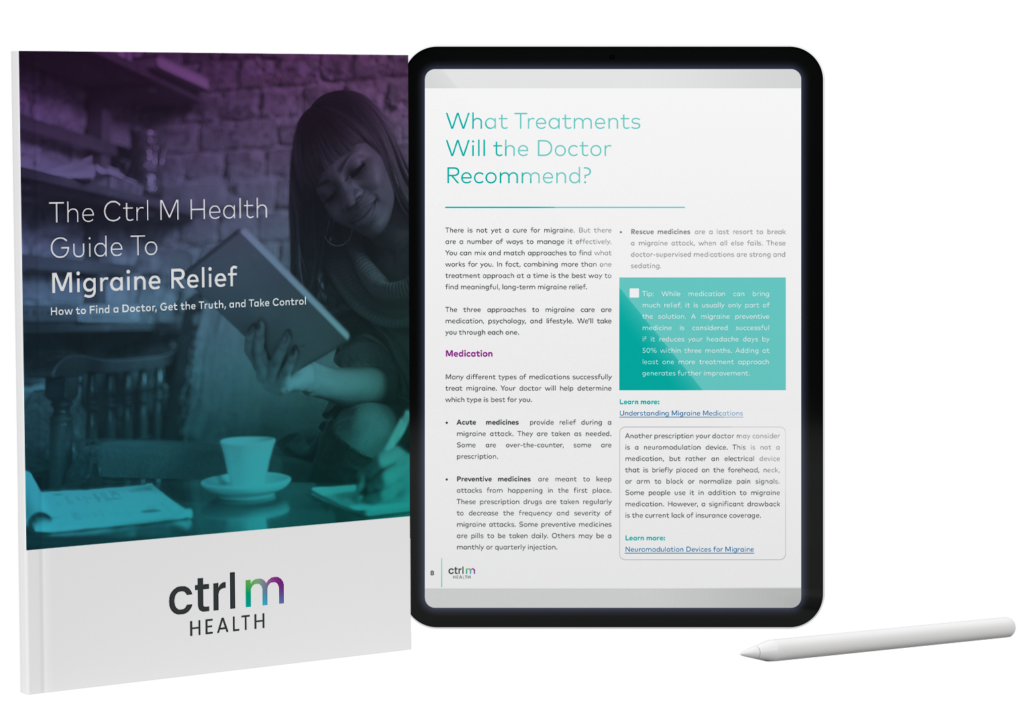Did you know that the medicine you’re using to fight your headaches could instead be making them worse? Taking too much over-the-counter or prescription pain medication puts you at risk for developing a condition known as “rebound headache syndrome.” Think of it as the “too much headache medicine” headache.
What is a Rebound Headache?
In rebound, the body develops a harmful adaptation to the medicine, so that the more medicine you take, the more your body needs to fight the pain. It becomes a vicious cycle, in which each time the pain-relieving medicine leaves your system, the pain returns more intensely, requiring more medicine. Once begun, the rebound cycle is hard to break.
Are you in rebound? Here are three rebound headache symptoms that indicate you may be taking too much pain medicine:
-
-
- If your head pain returns as soon as your abortive medicine wears off
- If you consistently wake up in the morning with a headache
- If you use simple pain relievers 10 or more days per month or combination analgesics more than four days a month.
-
Officially, rebound is listed in the International Classification of Headache Disorders as “medication-overuse headache.” But since that term sounds as though the patient is being blamed for their own headache — when they were just trying to feel better! — we prefer the terms “rebound” or “medication-adaptation” headache.
What Happens If You Take Too Much Migraine Medicine?
It’s thought that for people who are migraine-prone, taking too much medicine decreases the brain’s own ability to control pain. It also may increase the brain’s sensitivity, which can trigger more attacks. Imaging studies of patients with rebound headache syndrome actually show structural and functional changes in their brains. Those changes are largely reversible once the cycle is broken.
In the meantime, the rebound brain requires ever-higher doses of medicine, more frequently, and still can’t get relief. Many describe it as having a constant “background” headache.
How to prevent rebound headache in the first place:
-
-
- Do not take simple analgesics more than ten days a month
- Do not take combination analgesics more than six days a month, or triptans or ergotamine more than four days a month
- Even if you aren’t overusing any single type of medication, do not take any combination of pain medications more than ten days per month.
- When a new headache attack begins, treat it early enough to stop the pain and prevent lingering pain. This lingering pain is called recurrent headache, which is the same migraine coming back because the medicine has left the body before the migraine attack has run its course. Doctors suggest an association between such undertreated headaches and an increase in attacks and severity.
-
The Care Tuner Guide to Migraine Relief
Untreated migraine tends to worsen over time, so if you suspect you have migraine, it’s important to get help. We’ve compiled everything you need, including what to expect, pitfalls to avoid, and what you can do right now to get relief.

How Often to Take Medicine for Pain Relief
When taken too frequently, medications meant to cure headaches actually cause more headaches. It’s essential to take pain relievers as directed:
-
- Acetaminophen (Tylenol) or NSAIDs (aspirin, diclofenac, ibuprofen/Motrin/Advil, naproxen/Aleve/anaprox, indomethacin, ketorolac/toradol, nabumetone/Relafen) — no more than ten days per month
- Triptans, ergotamine, DHE (dihydroergotamine mesylate) — no more than four days per month
- Combination analgesic medications (Excedrin, Anacin, Tylenol with codeine) — no more than six days per month
- Opioids and medications containing butalbital (Fioricet, Fiorinal) — no more than four days per month. Some doctors recommend against using them at all.
Breaking The Rebound Headache Cycle
To break the rebound cycle, you’ll need to change your medication habits. Unfortunately, that may bring more pain in the short run. In addition to your headaches getting worse, you could get withdrawal symptoms, like nervousness, restlessness, nausea, vomiting, insomnia and constipation. Withdrawal tends to last from two to ten days. For some people, it can go on for several weeks. To get your system back to its normal baseline, it’s important to make an action plan with your provider.
-
-
- Cold turkey. If you’ve been taking simple analgesics, you and your doctor may decide to eliminate your quick fix meds completely.
- Tapering. You may both decide to bring your medication usage down more gradually.
- Short term withdrawal treatment. You and your doctor may decide that medication is needed to help you break the cycle. Options include corticosteroids, prochlorperazine, nerve blocks, DHE and anti-nausea medicine.
- Detox. If you’ve been relying on opioids or barbiturate-containing medicines (such as Fioricet or Fiorinal), the withdrawal symptoms may be severe enough to require medical supervision via a brief hospitalization. In the hospital, you can expect to receive intravenous doses of DHE-45 (dihydroergotamine-45), as well as anti-nausea and sedating drugs.
-
After breaking the rebound cycle, many people return to their original pattern of headache frequency and severity. It’s a great opportunity for you and your doctor to establish a new, effective medication plan for your migraine attacks. At this point doctors also usually prescribe a preventive migraine medication, to help reduce headache frequency and severity, so that you no longer have to rely on those pain-relief meds.
To find out which natural supplements for migraine best complement your care, try taking this quiz.





